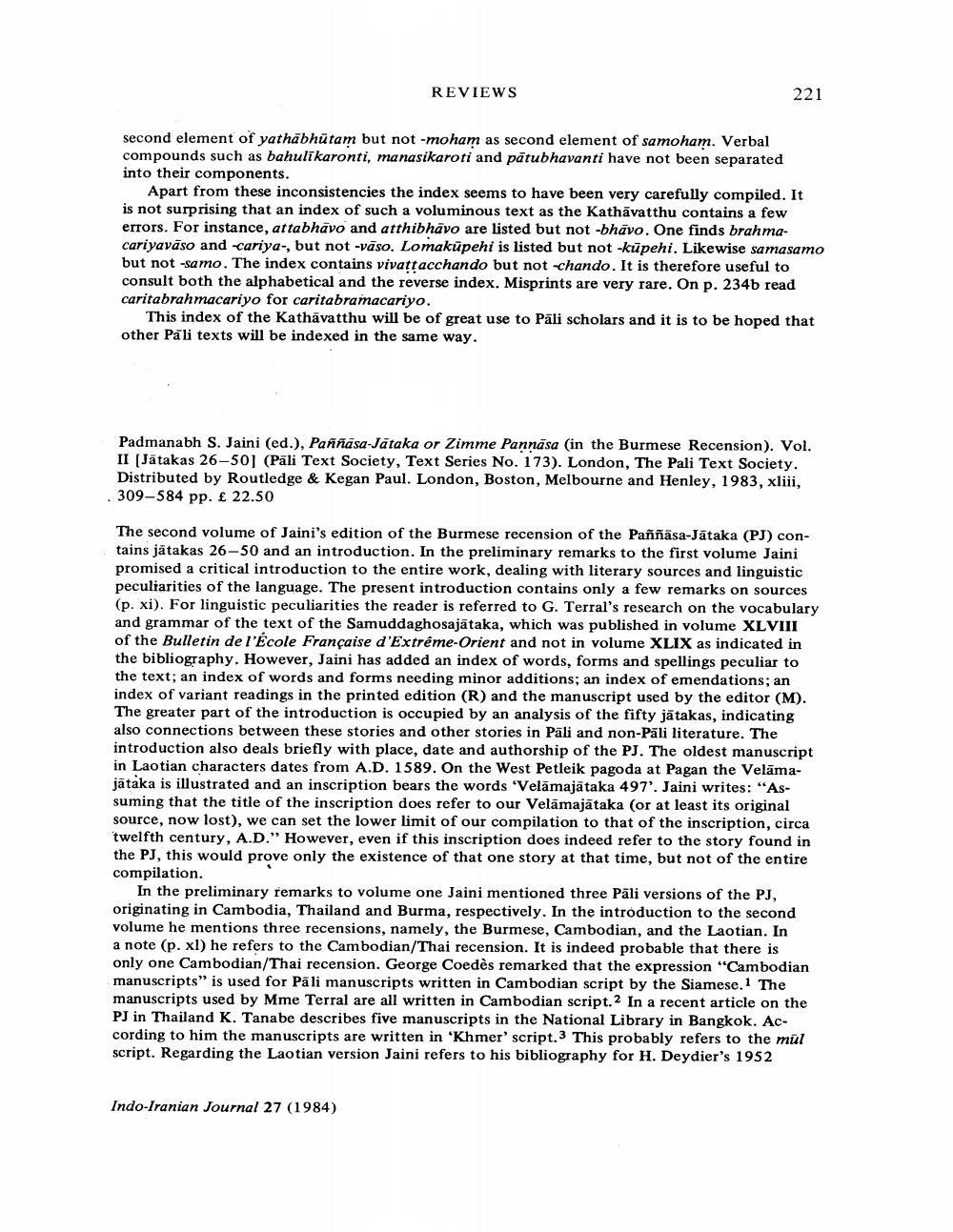________________
REVIEWS
221
second element of yathābhūtam but not -moham as second element of samoham. Verbal compounds such as bahulīkaronti, manasikaroti and pātubhavanti have not been separated into their components.
Apart from these inconsistencies the index seems to have been very carefully compiled. It is not surprising that an index of such a voluminous text as the Kathāvatthu contains a few errors. For instance, attabhāvo and atthibhāvo are listed but not -bhāvo. One finds brahmacariyavāso and cariya-, but not -vāso. Lomaküpehi is listed but not kūpehi. Likewise samasamo but not-samo. The index contains vivattacchando but not chando. It is therefore useful to consult both the alphabetical and the reverse index. Misprints are very rare. On p. 234b read caritabrahmacariyo for caritabramacariyo.
This index of the Kathāvatthu will be of great use to Pāli scholars and it is to be hoped that other Pāli texts will be indexed in the same way.
Padmanabh S. Jaini (ed.), Paññāsa-Jätaka or Zimme Pannäsa (in the Burmese Recension). Vol. II (Jätakas 26-50] (Pali Text Society, Text Series No. 173). London, The Pali Text Society. Distributed by Routledge & Kegan Paul. London, Boston, Melbourne and Henley, 1983, xliii, 309-584 pp. £ 22.50
The second volume of Jaini's edition of the Burmese recension of the Paññāsa-Jätaka (PJ) contains jätakas 26-50 and an introduction. In the preliminary remarks to the first volume Jaini promised a critical introduction to the entire work, dealing with literary sources and linguistic peculiarities of the language. The present introduction contains only a few remarks on sources (p. xi). For linguistic peculiarities the reader is referred to G. Terral's research on the vocabulary and grammar of the text of the Samuddaghosajātaka, which was published in volume XLVIII of the Bulletin de l'Ecole Francaise d'Extrême-Orient and not in volume XLIX as indicated in the bibliography. However, Jaini has added an index of words, forms and spellings peculiar to the text; an index of words and forms needing minor additions; an index of emendations; an index of variant readings in the printed edition (R) and the manuscript used by the editor (M). The greater part of the introduction is occupied by an analysis of the fifty jätakas, indicating also connections between these stories and other stories in Pāli and non-Pāli literature. The introduction also deals briefly with place, date and authorship of the PJ. The oldest manuscript in Laotian characters dates from A.D. 1589. On the West Petleik pagoda at Pagan the Velāmajātaka is illustrated and an inscription bears the words 'Velāmajätaka 497'. Jaini writes: "Assuming that the title of the inscription does refer to our Velāmajātaka (or at least its original source, now lost), we can set the lower limit of our compilation to that of the inscription, circa twelfth century, A.D." However, even if this inscription does indeed refer to the story found in the PJ, this would prove only the existence of that one story at that time, but not of the entire compilation.
In the preliminary remarks to volume one Jaini mentioned three Pāli versions of the PJ, originating in Cambodia, Thailand and Burma, respectively. In the introduction to the second volume he mentions three recensions, namely, the Burmese, Cambodian, and the Laotian. In a note (p. xl) he refers to the Cambodian/Thai recension. It is indeed probable that there is only one Cambodian/Thai recension. George Coedès remarked that the expression “Cambodian manuscripts" is used for Pāli manuscripts written in Cambodian script by the Siamese. 1 The manuscripts used by Mme Terral are all written in Cambodian script.In a recent article on the PJ in Thailand K. Tanabe describes five manuscripts in the National Library in Bangkok. According to him the manuscripts are written in 'Khmer' script.3 This probably refers to the mul script. Regarding the Laotian version Jaini refers to his bibliography for H. Deydier's 1952
Indo-Iranian Journal 27 (1984)




